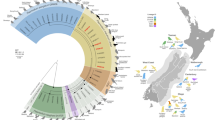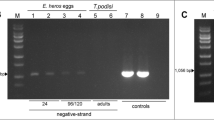Abstract
In the present study, 16 samples representing Fasciola (Platyhelminthes: Trematoda: Digenea) from sheep and cattle from seven geographical locations in Niger were characterized genetically by sequences of the first (ITS-1) and second (ITS-2) internal transcribed spacers (ITS) of nuclear ribosomal DNA (rDNA). The ITS rDNA was amplified from individual liver flukes by polymerase chain reaction (PCR), and the amplicons were sequenced directly. The lengths of the ITS-1 and ITS-2 sequences were 422 and 361/362 bp, respectively, for all liver fluke samples sequenced. Comparison of the ITS sequences of the Niger Fasciola samples examined in the present study with that of Fasciola hepatica, Fasciola gigantica, and the “intermediate Fasciola” from elsewhere revealed that the Niger Fasciola samples examined represent two species, namely F. hepatica and F. gigantica. This is the first demonstration of the existence of both F. hepatica and F. gigantica in Niger by a genetic approach, which provides foundation for further studies on F. hepatica and F. gigantica in Niger and has implications for studying the population genetic structure of the Niger Fasciola and for the diagnosis and control of the disease they cause.

Similar content being viewed by others
References
Agatsuma T, Arakawa Y, Iwagami M, Honzako Y, Cahyaningsih U, Kang SY, Hong SJ (2000) Molecular evidence of natural hybridization between Fasciola hepatica and F. gigantica. Parasitol Int 49:231–238
Alasaad S, Huang CQ, Li QY, Granados JE, García C, Pérez JM, Zhu XQ (2007) Characterisation of Fasciola samples from different host species and geographical localities in Spain by sequences of internal transcribed spacers of rDNA. Parasitol Res 101:1245–1250
Chilton NB, Gasser RB, Beveridge I (1995) Differences in a ribosomal DNA sequence of morphologically indistinguishable species within the Hypodontus macropi complex (Nematoda: Strongyloidea). Int J Parasitol 25:647–651
Haseeb AN, el-Shazly AM, Arafa MA, Morsy AT (2002) A review on fascioliasis in Egypt. J Egypt Soc Parasitol 32:317–354
Huang WY, He B, Wang CR, Zhu XQ (2004) Characterisation of Fasciola species from Mainland China by ITS-2 ribosomal DNA sequence. Vet Parasitol 120:75–83
Ishii Y, Nakamura-Uchiyama F, Nawa Y (2002) A praziquantel-ineffective fascioliasis case successfully treated with triclabendazole. Parasitol Int 51:205–209
Itagaki T, Tsutsumi K (1998) Triploid form of Fasciola in Japan: genetic relationships between Fasciola hepatica and Fasciola gigantica determined by ITS-2 sequence of nuclear rDNA. Int J Parasitol 28:777–781
Itagaki T, Kikawa M, Sakaguchi K, Shimo J, Terasaki K, Shibahara T, Fukuda K (2005a) Genetic characterization of parthenogenic Fasciola sp. in Japan on the basis of the sequences of ribosomal and mitochondrial DNA. Parasitology 131:679–685
Itagaki T, Kikawa M, Terasaki K, Shibahara T, Fukuda K (2005b) Molecular characterization of parthenogenic Fasciola sp. in Korea on the basis of DNA sequences of ribosomal ITS1 and mitochondrial NDI gene. J Vet Med Sci 67:1115–1118
Keyyu JD, Kassuku AA, Msalilwa LP, Monrad J, Kyvsgaard NC (2006) Cross-sectional prevalence of helminth infections in cattle on traditional, small-scale and large-scale dairy farms in Iringa district, Tanzania. Vet Res Commun 30:45–55
Lin RQ, Dong SJ, Nie K, Wang CR, Li AX, Song HQ, Huang WY, Zhu XQ (2007) Sequence analysis of the first internal transcribed spacer of rDNA supports the existence of an intermediate Fasciola between F. hepatica and F. gigantica in Mainland China. Parasitol Res 101:813–817
Luton K, Walker D, Blair D (1992) Comparisons of ribosomal internal transcribed spacers from two congeneric species of flukes (Platyhelminthes: Trematoda: Digenea). Mol Biochem Parasitol 56:323–327
Mas-Coma MS, Esteban JG, Bargues MD (1999) Epidemiology of human fascioliasis: a review and proposed new classification. Bull World Health Organ 77:340–346
Mas-Coma S, Bargues MD, Valero MA (2005) Fascioliasis and other plant-borne trematode zoonoses. Int J Parasitol 35:1255–1278
Mekroud A, Titi A, Benakhla A, Rondelaud D (2006) The proportion of liver excised in Algerian abattoirs is not a good indicator of Fasciola hepatica infections in local cattle breeds. J Helminthol 80:319–321
Mungube EO, Bauni SM, Tenhagen BA, Wamae LW, Nginyi JM, Mugambi JM (2006) The prevalence and economic significance of Fasciola gigantica and Stilesia hepatica in slaughtered animals in the semi-arid coastal Kenya. Trop Anim Health Prod 38:475–483
Pfukenyi DM, Mukaratirwa S, Willingham AL, Monrad J (2006) Epidemiological studies of Fasciola gigantica infections in cattle in the highveld and lowveld communal grazing areas of Zimbabwe. Onderstepoort J Vet Res 73:37–51
Phiri AM, Phiri IK, Chota A, Monrad J (2007) Trematode infections in freshwater snails and cattle from the Kafue wetlands of Zambia during a period of highest cattle–water contact. J Helminthol 81:85–92
Spithill TW, Dalton JP (1998) Progress in development of liver fluke vaccines. Parasitol Today 14:224–228
Vara-Del Río MP, Villa H, Martinez-Valladares M, Rojo-Vázquez FA (2007) Genetic heterogeneity of Fasciola hepatica isolates in the northwest of Spain. Parasitol Res 101:1003–1006
Yamaguti S (1958) Systema helminthum, vol I. The digenetic trematodes of vertebrates. Interscience Publishers, New York
Zhu XQ, D’Amelio S, Palm HW, Paggi L, George-Nascimento M, Gasser RB (2002) SSCP-based identification of members within the Pseudoterranova decipiens complex (Nematoda: Ascaridoidea: Anisakidae) using genetic markers in the internal transcribed spacers of ribosomal DNA. Parasitology 124:615–623
Acknowledgments
Project support was provided in part by grants from the Program for Changjiang Scholars and Innovative Research Team in Chinese Universities (grant no. IRT0723) to XQZ and from the International Foundation for Science (IFS; grant no. B/4184-1) to HA. The authors would like to thank the kind collaboration of many people for assistance in collection of Fasciola samples. The experiments comply with the current laws of the countries in which the experiments were performed.
Author information
Authors and Affiliations
Corresponding author
Additional information
H. Ali and L. Ai contributed equally to this work.
Rights and permissions
About this article
Cite this article
Ali, H., Ai, L., Song, H.Q. et al. Genetic characterisation of Fasciola samples from different host species and geographical localities revealed the existence of F. hepatica and F. gigantica in Niger. Parasitol Res 102, 1021–1024 (2008). https://doi.org/10.1007/s00436-007-0870-7
Received:
Accepted:
Published:
Issue Date:
DOI: https://doi.org/10.1007/s00436-007-0870-7




